Chemical imbalance
Formulating success with four jig techniques

————————————–
Editor’s note: Learn more about FLW Outdoors Magazine and how to subscribe by clicking here.
————————————–
They’re as simple as fishing lures get. Yet, there’s nothing simple about them.
At one end of the spectrum, its most basic end, a jig is nothing more than lead, iron and carbon – three members of the periodic table of chemical elements that have little to do with one another. But, thanks to processes many of us learned about in middle-school chemistry class, when iron alloy is combined with just the right amount of carbon gas it creates steel, which can be formed into a hook. Then pour and cool some molten lead into a specific shape around that steel hook, and, voila, you have a jig.
At the other end of the spectrum, the practical end, jigs get far more complex. Leaving out the unfathomable number of colors, finishes, trailers, skirts, shapes and sizes, jigs possess the ability to be fished in any way possible. And here’s the kicker: None of them are wrong. It doesn’t matter if you’re tossing a 1-ounce jig in a foot of water. Stick with it long enough and it will catch a fish. However, there are better, or at least, more preferred ways to fish them, like pitching, vertical jigging, snapping and dragging.
But even if you focus only on these four techniques, further investigation and experimentation makes the complexity of a jig only deepen. Like you learned back in chemistry, change one element and the end product can be completely different. It’s the same with all of these styles. While each technique has a multitude of elements that make it work, each has one key element that makes it work better for the pros. And here they are.
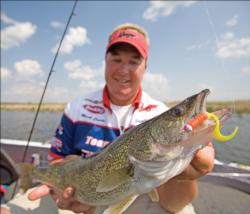 Pitching
Pitching
Scientist: Mark Courts
Key element: Jig weight
It only takes a small amount of sodium dropped into water to create an explosion. It’s the same principle when pitching jigs: A tiny jig does more than enough damage. Actually, the smaller the jig the better.
“I like to pitch the lightest jig I can get by with,” said pro Mark Courts of Harris, Minn. “That’s the biggest thing to be successful pitching.”
The reasoning behind this is the action. A lighter jig, when paired with a soft-lure trailer like a Berkley Gulp Alive 3-inch Minnow, simply looks natural coming through the water. With little mass holding it down, the jig hovers as it swims along, while the fall is slower and more angled compared to the abrupt, straight-down fall of a heavier jig.
There’s also another reason for the featherweight: its ability around cover. In lakes, classic pitching cover usually consists of emergent weedbeds, with gravelly points being a handy plan B in the spring. Weedbeds usually aren’t thick enough to have pockets by then, so Courts focuses his efforts on swimming the jig over the top to cover as much water as he can while the light weight lets him keep the lure in front of the fish.
“Because the jig is so light – usually a 1/16- or 1/32-ounce – when I let it fall, it will actually rest on top of the weeds instead of burying like a heavier jig,” Courts said. “This means the bait is always out in the 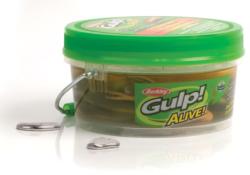 open. And if it does get caught in the weeds, the smaller jig is much easier to pop out.”
open. And if it does get caught in the weeds, the smaller jig is much easier to pop out.”
Even when weeds grow thicker come summer and the focus becomes more on pockets, stick with a light jig for a long enough fall to tease fish buried in the weeds.
Rivers, however, present different cover and problems. But the light frame of mind still applies.
“In a river there’s current, so you want a heavy enough jig to keep contact with the bottom but still flow along,” Courts said. “An 1/8-ounce jig seems to work the best for me. But I’ll go up to 1/4 ounce in stronger currents.”
As for cover, everything is open to pitching, with some of Courts’ favorites being riprap, stumps and timber, rock piles, and even day markers. However, these types of cover tend to have a snaggy 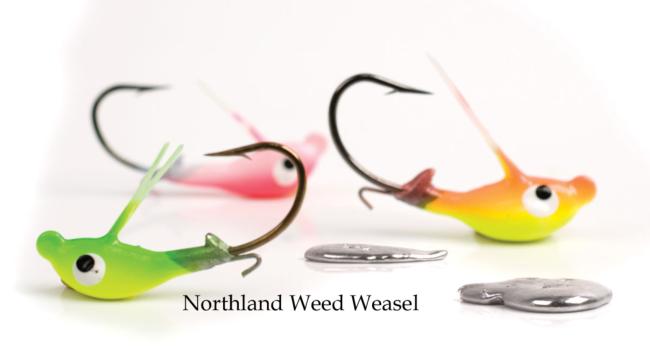 demeanor, so make the swap from a regular jig to a weedless one like a Northland Weed Weasel. Also, while Courts usually prefers monofilament line for pitching, he opts for Berkley FireLine to fight abrasion when pitching into abrasive cover.
demeanor, so make the swap from a regular jig to a weedless one like a Northland Weed Weasel. Also, while Courts usually prefers monofilament line for pitching, he opts for Berkley FireLine to fight abrasion when pitching into abrasive cover.
From there it’s a matter of dissecting the cover. Because the current can hit and deflect so many different ways around a piece of cover, always try to make two or three pitches from varying angles before moving on to the next piece.
Vertical jigging
Scientist: Tom Keenan
Key element: Jig weight
Yes, this technique has the same key element as pitching. But, the same element can have different effects depending on the amount mixed. Take nitric acid, for example. Mix a miniscule amount with ethanol and you get a toxic gas. Mix a large amount, keep it under pressure and say goodbye to your eyebrows, or worse.
The right mix of jig and technique can have the same results. A light jig gets the desired reaction for 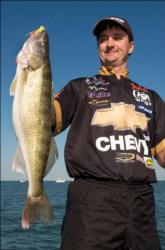 pitching, but it can leave you with only hot air when going vertical. One of the most common mistakes anglers make when vertical jigging is not using a heavy enough jig.
pitching, but it can leave you with only hot air when going vertical. One of the most common mistakes anglers make when vertical jigging is not using a heavy enough jig.
“We’ve all been taught for years to use the smallest jig possible because it’s easier for the fish to eat,” Chevy pro Tom Keenan of Hatley, Wis., said. “I don’t think that’s true, especially for vertical jigging. You want to use a heavier jig so it’s easier to feel when it contacts the bottom. A smaller jig doesn’t help if you can’t feel the bottom. So when in doubt, use a heavier jig.”
So, how heavy is heavy enough? Considering this technique is mainly for rivers, jig weight should depend on depth and current. For most scenarios, a 1/4-ounce jig should do the trick. But the pro has been known to bulk up to a 5/8- or 3/4-ounce jig to deal with deep or fast water.
As for the jig itself, Keenan prefers a stand-up jig like a Big Bite Baits Bio Bug. And he always, extra emphasis on always, uses a stinger hook placed on the back of the minnow or soft bait he’s using.
Once he has determined a jig weight, putting it to good use is the next step. As stated before, vertical jigging is predominantly a river technique, and for Keenan it typically works best around the spawn. With that in mind, he looks for breaklines and flats close to spawning areas. He’ll pick a depth and let the current push the boat across the area as he uses the trolling motor to keep the boat over that depth.
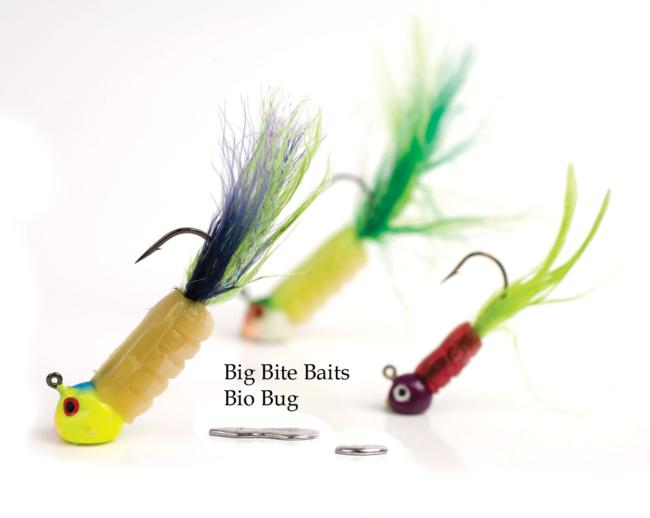
Keeping the line as perfectly vertical as possible while moving is almost as important as jig weight. Not only is it easier to feel bottom with the jig straight below the rod tip, but it also helps for hookups. Berkley FireLine in 8- to 10-pound test cuts through the water better and is more sensitive than monofilament, making it a good choice to help stay vertical.
Keenan likes to tie a swivel at the end of the FireLine and attach an 18- to 24-inch fluorocarbon leader so fish can’t see the line, and because it’s easier to break off if he gets snagged, which will happen.
One last tidbit Keenan focuses on is the drop. Vertical jigging requires a steady lift-and-drop cadence. But instead of just letting the jig free-fall, Keenan likes to do what he calls “tight-lining.”
“It’s a controlled fall,” Keenan said. “A lot of anglers just let the jig drop to the bottom. I set it on the bottom. This way I’m always in control and I can always feel when a fish picks it up.”
Snapping
Scientist: Tommy Skarlis
Key element: The snap
Talk about Captain Obvious. Saying the snap is the key to snap jigging is like saying heat is the key to boiling water. So let’s break it down a little more and be more specific. The keys are identifying and  connecting on strikes throughout the snap. To do that, however, an angler has to perform a proper snap. So we’re back to the original point: The key to this technique is the snap. Don’t you love it when things come full circle?
connecting on strikes throughout the snap. To do that, however, an angler has to perform a proper snap. So we’re back to the original point: The key to this technique is the snap. Don’t you love it when things come full circle?
The proper snap begins with good form. At the start, the elbow of the arm holding the rod should be tucked close to the body, while the forearm and hand rest at the 3 to 4 o’clock position. From there, make a fast but controlled snap upward with just the hand and forearm to the 2 o’clock position – maybe 1:30 if you get a little overzealous. Then drop the rod back to the original position and repeat until your arm feels like it’s about to fall off.
So, how does this help with hookups? Well, there are two main areas to concentrate. The first is when the rod drops, letting the jig free-fall back to the bottom – pro Tommy Skarlis of Waukon, Iowa, likes a 1/8- or 1/4-ounce Lindy Fuzz-E-Grub or Lindy X-Change Jig System jig tipped with a minnow, shiner or Berkley Gulp Alive Minnow.
“I notice a lot of anglers just let the jig free-fall on slack line,” Skarlis said. “Most bites will come when the jig is falling, so if an angler is just letting it fall on slack line he won’t feel the bite.
“Follow the jig. Don’t restrict the jig from falling, but keep enough contact with it to recognize when its fall stops a few inches shorter than it should have. Whenever that happens, it’s usually because it’s sitting in the mouth of a walleye.”
The second area is the actual snap. Even pros can’t detect every bite on the fall, but they sure can 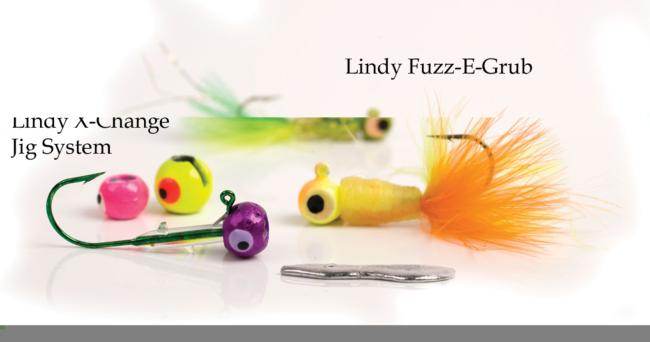 when they’re about to snap. That’s where a smooth transition from a snapping motion to a hookset plays a big role in sticking a fish.
when they’re about to snap. That’s where a smooth transition from a snapping motion to a hookset plays a big role in sticking a fish.
“You can’t double-clutch,” Skarlis said. “The second you feel something different – weight, a tick, anything – you have to react quickly. As long as you’re making controlled snaps, you should be able to stay in control and continue the snapping motion into a hookset.”
Whenever a bite or potential bite is detected on the snap, continue to lift the forearm and hand to the 12 or even 11 o’clock position to get a good bend in the rod. While it seems like the snap alone should be enough to stick a hook, a prolonged hookset is what’s necessary to consistently get hookups. A 7-foot Fenwick Techna AV with a medium-fast action is long enough to help lessen fatigue and perform a good snap. Plus, the fast action helps response time and helps bury the hook.
And don’t worry about setting the hook anytime you feel something different, even when there is no fish. Even Skarlis, the winner of the 2008 Walmart FLW Walleye Tour Championship, admitted he has been known to set the hook on everything from weeds to pebbles. But it keeps him alert, gives him good practice and it means he doesn’t miss many fish.
Dragging
Scientist: Jason Kerr
Key element: Jig style
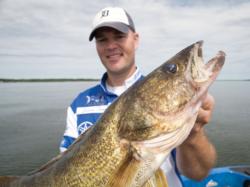
There are 117 elements on the periodic table. If someone took the time to count there might be just as many styles of jigs. Maybe not. Either way, there are a lot of jigs to choose from. And while many will work for dragging, the best keep the hook off the bottom.
“There are two things I look for when choosing a jig for dragging,” said Owatonna, Minn., pro Jason Kerr. “First is a wide-gap hook. The second, and probably more important, is a stand-up or semistand-up jig.”
Let’s break down the two characteristics. The idea of dragging a large hook capable of snagging cover probably sounds counterproductive. But anglers must remember this technique is generally done across a clean bottom. Plus, the wide gap can really increase hookups.
As for the jighead style, like mentioned before, many will work. But a stand-up or semistand-up jig keeps the hook from lying on the bottom. Aside from protecting against snags, the upright barb also lets a half crawler – Kerr’s bait choice – wriggle around better to entice sluggish fish.
“Generally, dragging works best when fish are in a neutral or negative mood,” Kerr said. “It’s perfect for when the fish are just lying down there but aren’t willing to chase a bait. They see that worm wiggling by them nice and slow, and it usually gets them to bite.”
That was the case at the championship in 2008. While plenty of pros tried to troll up a winning limit on the Missouri River, the ones who scored big, including the previously mentioned Skarlis, were dragging. 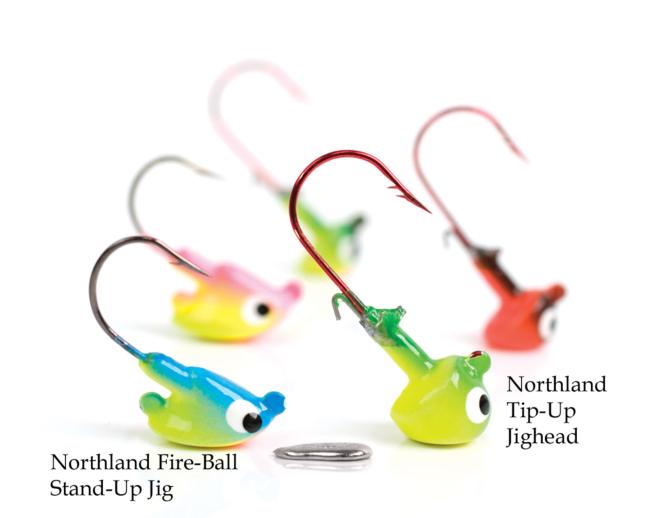 It was an eye-opening experience for Kerr, who has since devoted a lot of time to the technique, with incredible success.
It was an eye-opening experience for Kerr, who has since devoted a lot of time to the technique, with incredible success.
“It’s deadly, and it’s fun,” Kerr said. “The more I do it the more productive I realize it can be.”
Kerr’s favorite areas to drag a jig are inside weed edges and sandy bottoms with irregularities. Once he finds a suitable spot, he’ll set the boat upwind of the area and let out his line.
“You only want to let out enough line that the jig can touch the bottom and literally drag without coming off the bottom,” Kerr said.
From there, he uses drift socks or the trolling motor to control speed and direction as the wind drifts the boat over the spot.
As for gear, a 1/8-ounce jig is usually heavy enough, since it’s a shallow technique. And a long rod is a must for picking up line or dropping the tip to feed line on a bite.
In the end, dragging is still a relatively new technique to Kerr. And he admitted he and other pros are still learning the nuances. But it’s one all anglers should experiment with as this technique is definitely here to stay.